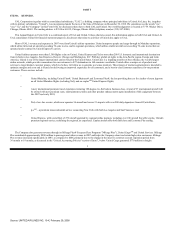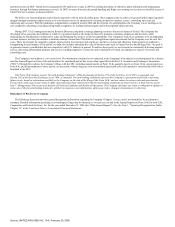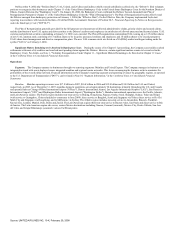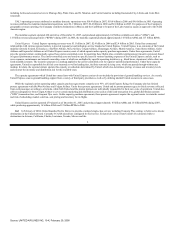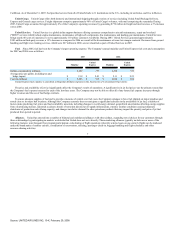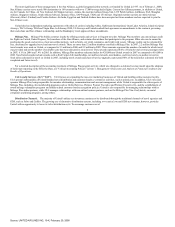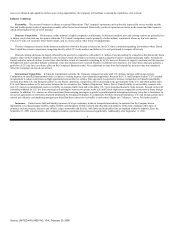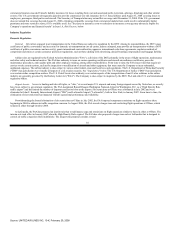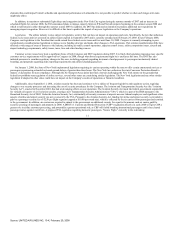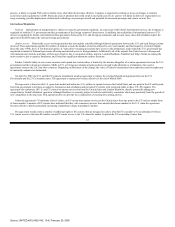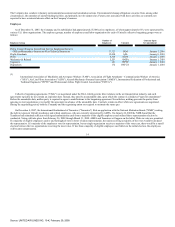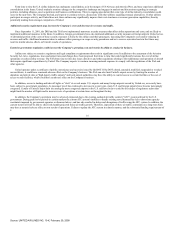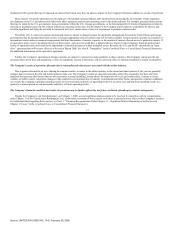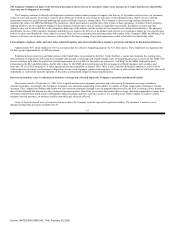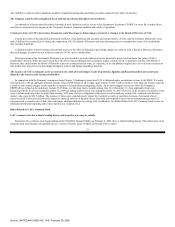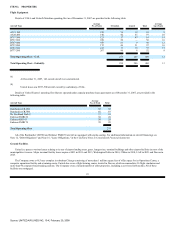United Airlines 2007 Annual Report Download - page 14
Download and view the complete annual report
Please find page 14 of the 2007 United Airlines annual report below. You can navigate through the pages in the report by either clicking on the pages listed below, or by using the keyword search tool below to find specific information within the annual report.
50 percent of a U.S. carrier will not be presumed to violate the actual control by U.S. citizens requirement, provided foreign ownership of the voting equity of the
U.S. carrier does not exceed the statutory limit of 25 percent. U.S. ownership of EU carriers may not exceed 49.9 percent and the EU may enact future legislation
restricting U.S. ownership of the voting stock of EU airlines to 25 percent. The agreement also provides EU passenger carriers with the right to operate between
the U.S. and a limited number of non-EU countries and does not provide reciprocal rights to U.S. carriers.
The EU/U.S. open skies agreement will likely directly impact the future value and expected lives of route authorities to Heathrow; however, there is no
direct impact from the open skies agreement on airport slot rights, including those at Heathrow. The open skies agreement is also expected to provide United and
other carriers with access to new markets in EU countries. In September 2007, the DOT granted United antitrust immunity with bmi. The immunity goes into
effect at the same time as the open skies agreement between the U.S. and EU at the end of March 2008. Because of the diverse nature of potential impacts on
United's business from the EU transatlantic aviation agreement, the overall future impact of the agreement on United's business in the EU region cannot be
predicted with certainty.
The European Commission (the "Commission") is expected to propose important new legislation or to adopt interpretive guidance that will impact the
Company. The Commission recently proposed legislation that would significantly deregulate the current Computer Reservation System ("CRS") Code of
Conduct. If adopted, this legislation may lead to lower airline distribution costs in Europe. The Commission may also take steps to officially sanction secondary
slot trading, which is a current practice among carriers that involves the sale, purchase or lease of slots. If adopted, that legislation or interpretive guidance should
resolve disputes about the legality of slot exchanges at EU airports and permit carriers to continue with this longstanding practice. In addition, legislation to
include aviation within the EU's existing emissions trading scheme is currently being considered within the EU legislative process. If adopted, such a measure
could add significantly to the costs of airlines operating in the EU member states. The precise cost to United will depend upon the terms of the legislation
enacted, which would determine whether United will be forced to buy emission allowances and the cost at which these allowances may be obtained.
Pursuant to an agreement reached in December 2005, a full open skies agreement between the United States and Canada came into force in 2007. The DOT
also approved the 9-party antitrust immunity application (including United, Air Canada, Lufthansa, SAS, Austrian, Swiss, LOT, TAP and bmi), allowing United
and Air Canada to expand their existing antitrust immunity beyond the currently allowed transborder region.
Environmental Regulation.
The airline industry is subject to increasingly stringent federal, state, local, and foreign environmental laws and regulations concerning emissions to the air,
discharges to surface and subsurface waters, safe drinking water, and the management of hazardous substances, oils, and waste materials. New regulations
surrounding the emission of greenhouse gases (such as carbon dioxide) are being considered for promulgation both internationally and within the United States.
United is carefully evaluating the potential impact of such proposed regulations. Other areas of developing regulations include the State of California
rule-makings regarding air emissions from ground support equipment and a federal rule-making concerning the discharge of deicing fluid. The airline industry is
also subject to other environmental laws and regulations, including those that require the Company to remediate soil or groundwater to meet certain objectives.
Compliance with all environmental laws and regulations can require significant expenditures. Under the federal Comprehensive Environmental Response,
Compensation and Liability Act, commonly known as "Superfund," and similar environmental cleanup laws, generators of waste materials, and owners or
operators of facilities, can be subject to liability for investigation and remediation costs at locations that have been identified as requiring response actions.
13
Source: UNITED AIR LINES INC, 10-K, February 29, 2008


